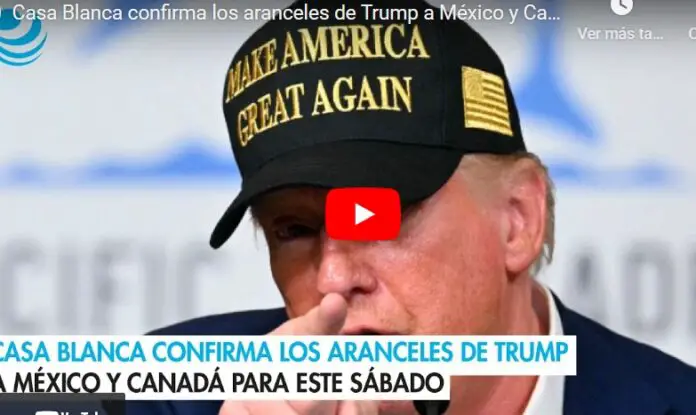US President Donald Trump is sticking to his plan to apply 25% tariffs on imports of products originating in Mexico starting this Saturday, White House spokeswoman Karoline Leavitt told reporters.
Leavitt said Tuesday that tariffs on imports from Mexico, as well as those from Canada, remain scheduled to begin on February 1, unless both countries help address the problems of fentanyl trafficking and immigration.
Last Thursday, Trump declared progress in reaching conciliation with Mexico regarding their concerns on issues related to migration and drug trafficking in the United States.
“With Mexico we are dealing, I think, very well and we just want to be treated fairly with other nations,” Trump said while participating – remotely – in a meeting of the World Economic Forum, held in Davos, Switzerland.
Following this message, Kenneth Smith, international trade specialist and partner at AGON, made this comment: “Just because Trump said in Davos that things are ‘going well’ with Mexico and attacked Canada does not mean that tomorrow he will not come out with ten times more aggressive comments against Mexico. That is his style: to generate disruption and uncertainty.”
Regarding Canada, Trump also said in Davos that for the United States it has been “very difficult to deal with over the years” with the Canadian authorities.
“We don’t need them to make our cars and they make many of them. We don’t need their wood because we have our forests, gas and oil, we have more than anyone else,” he added in reference to the Canadians.
Leavitt stressed that Trump is also still considering new tariffs on China for next Saturday.
Last Friday, the United States Trade Representative (USTR) launched two reviews, one focused on unfair trade practices and another to assess whether China has complied with its commitments in its phase one agreement with the United States.
An analysis by Banco Base concludes that the concentration of exports to the United States leaves the door open for it to be used to pressure the Mexican government on issues that may not be related to trade, as could happen during Trump’s second term to achieve objectives of immigration control, border security and stopping the flow of narcotics.
“Something positive about the growth of exports to the United States is that Mexico has specialized in manufactured products, which are within key supply chains for the United States. This makes them difficult to replace quickly,” said Gabriela Siller and Jesús Anacarsis López, analysts at Banco Base.
In Mexico, total exports account for 37.97% of the Gross Domestic Product (GDP), according to data from 2024 to the third quarter, and its growth is supported by trade with its North American partners.
Mexico is the United States’ main trading partner with 15.4% of total trade as of November 2024 (latest data available), followed by Canada with 13.8%, China with 11.3%, Germany with 4.3% and Japan with 4.2 percent.
Together, these five countries represent 50.2% of total U.S. trade.
According to Banco Base, from 2016 to date, China has lost 7.66 percentage points in the share of U.S. imports, as a result of the trade war and the relocation of companies. This has benefited Mexico, which has gained 2.16 percentage points of share in U.S. imports.
In its most recent action, the Trump administration announced on Sunday that it will not go ahead with its plans to impose a tariff of up to 50% on Colombia, threats that Trump made after the country rejected U.S. military planes with detained Colombian immigrants.
“The Government of Colombia agreed to all of President Trump’s terms, including the unrestricted acceptance of all illegal aliens from Colombia returning from the United States, including on U.S. military aircraft, without limitations or delays,” the White House announced in a statement.
The statement said the White House had drafted a legal memorandum outlining President Trump’s authority to use the International Emergency Economic Powers Act, which gives a president broad authority to control economic transactions if they declare an emergency.

How did the peso react?
A few hours before the close of the session on Tuesday, the Mexican peso cut its gains after the White House said that the date of February 1 for the imposition of tariffs on Mexico and Canada is still in place.
The exchange rate ended the day at the level of 20.5402 units per dollar. Compared to the record of 20.7278 pesos yesterday, with official data from the Bank of Mexico (Banxico), the movement meant a gain of 18.76 cents, equivalent to 0.91 percent.
The price of the dollar operated in a range between a maximum of 20.7831 units and a minimum of 20.5223 units.
The rebound of the peso occurred after it lost just over 2% yesterday, in a fearful reaction of the market after brief trade tensions between Colombia and the United States that revived fears over the weekend of Donald Trump’s tariff policy.
Source: eleconomista




